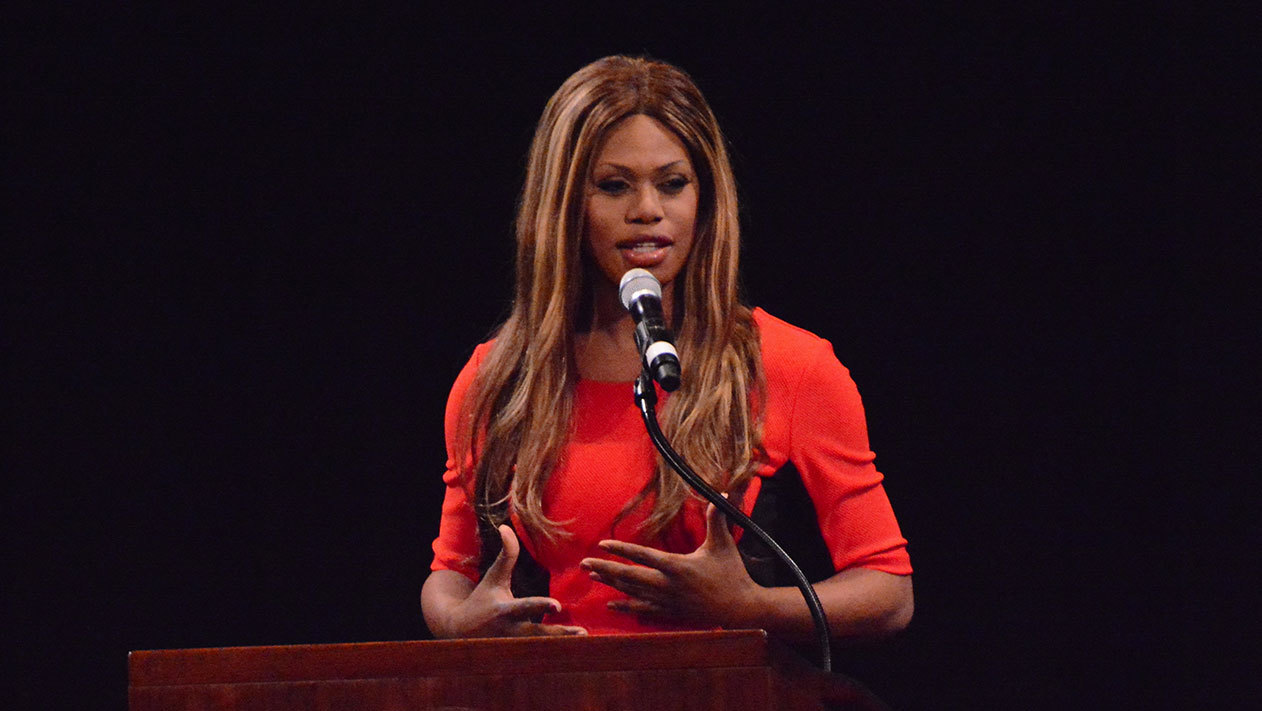“Transgender people were more represented in the media than any year I can ever remember in the past,” says punk rock queen Laura Jane Grace. As the lead singer of Against Me!, she came out as trans in an interview with Rolling Stone in 2012 and has been on an upward trajectory ever since. “It really felt like awareness for a real foothold in the social conversation too,” she tells i-D. “Enough so that it has to be taken seriously and can’t be dismissed and told to fuck off.” Why now, though? “I think it was just a tipping point. Enough momentum gathered.”
Much of that momentum gathered in the States, where trans women of colour, in particular, pushed the conversation onto the next level. It’s been an especially great year for Laverne Cox, who went indisputably mainstream. And thank goodness. There are few people who communicate the important political messages in as accessible language as Laverne. I asked her what her highlights were in 2014. “As a woman who is trans myself I had two personal highlights that many in my community also say they found very inspiring. Number one was being nominated for an Emmy for my work on Orange is The New Black. An out trans person has never been honoured in an acting category. Acting has been a lifelong dream of mine”.
Laverne tells me that she often felt that being trans would prevent her from becoming an actress. “I know I have much more work to do as an artist but this Emmy nomination is deeply validating for me as an artist. It makes me believe that anything is possible and being trans doesn’t have to ever hold me back.” No guessing what highlight number two is. “Being on the cover of Time Magazine was the second highlight. It’s another historic moment that I am super proud of.”
I also caught up with Adele Anderson – one third of cabaret troupe Fascinating Aida and also the first transgender woman to play a trans character on screen in the UK. She earned this honour back in 2000, and has been quietly playing trans roles on British telly for the past 15 years, appearing most recently in an episode of New Tricks. I asked her why she thinks we’re seeing all this now. “I think because the government has got behind it as well. I never thought in the early days that I would ever get a female birth certificate. So it was a nice surprise when I found that the law had changed and I could get that, and it’s sort of like a rollercoaster now and no one can stop it – and I think that’s a very good thing.”
She agrees that having more trans faces in the public eye has helped, too: “The public know more about the subject now. I think the public are much more disposed towards trans people than the press. Witness when Nadia won Big Brother. Then we had the Eurovision contest with Dana International, and now it’s all come round again with Conchita, so I think people are getting used to the fact that you don’t have to be this gender or that gender, you can vary how you feel.”
It wasn’t just the world of acting that welcomed trans people though. As I wrote for i-D back in August, the fashion world has seen an explosion of transgender models serving fabulous on the catwalk. Geena Rocera has had a runaway year – and is using her platform to energise Gender Proud, her global initiative to allow trans folks to be able to change gender markers on identification documents. Meanwhile, Andreja Pejic came out publicly as trans, Lea T landed a contract as the face of Redken hair products and Candy magazine rounded off the year with a Vanity Fair-style glamorous cover featuring no less than 14 inspirational trans women. Fashion was our friend in 2014.
However, while 2014 has certainly been cause for celebration within the trans community, there is still a long way to go. Public appreciation of successful trans women is a welcome step forward, but, for many trans people, their every day lives still look very much like the dark old days. Take Mikki Nicholson, a transgender woman in her early 30s who took her life just last month – just in time for her name to be added to the list of dead trans people honoured on Transgender Day of Remembrance. It’s not just suicide that blights the community, though. Other people are on hand to take our lives too, like the young transgender woman who has drowned in a toilet earlier this year. Her killer, Joseph Scott Pemberton, told colleagues “I think I killed a he-she”. Such is the value placed on transgender women’s lives.
Laverne agrees that there is much to do in 2015. “I would love to see Monica Jones conviction overturned in Phoenix, Arizona and the unconstitutional law of manifesting intent to commit prostitution be stricken from the law books in Arizona.” Jones was convicted of “manifesting prostitution” earlier this year: advocates argue that trans women of colour are disproportionately and unfairly targeted by police in the States. Conversely, murders of trans women are seldom investigated with any zeal. “I would like to see the murders of Islam Nettles, Jennifer Laude and many other trans folks across the world brought to justice,” says Cox. “I want to see trans lives treated as if they matter, as if they have value through the ways in which we treat each other and public policy.”
So, was 2014 a tipping point for transgender acceptance? I’ll let Laverne have the last word on that. “I believe it will be a tipping point if we can continue to translate this unprecedented visibility into real political and cultural change.”
Credits
Text Paris Lees
